Google Nexus 4 and Nexus 10 Performance Preview
by Anand Lal Shimpi & Brian Klug on November 2, 2012 11:00 AM ESTGPU Performance
This section is particularly exciting because it's our first look at ARM's new Mali-T604 GPU in our standard mobile 3D performance suite. We've already seen the Nexus 4's Adreno 320 in action, but the Nexus 10's behavior here should be interesting to see.
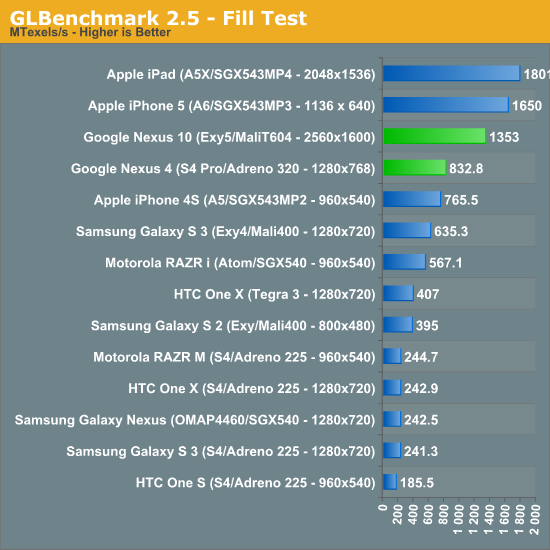
As far as raw fillrates are concerned, both Nexus devices do quite well here at their native resolutions. The iPad and iPhone 5 are both quicker, but we're still good gains over the previous generation of hardware - particularly for the Mali-T604. Compared to the Mali-400MP4 in the Galaxy S 3, we're seeing more than 2x the performance out of ARM's latest GPU.
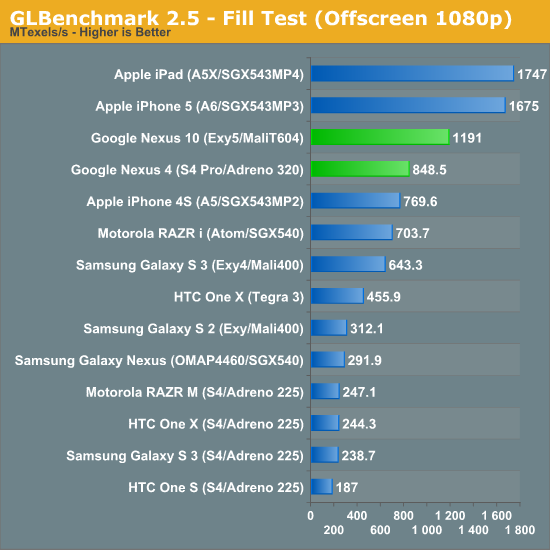
At normalized resolutions the standings don't really change.
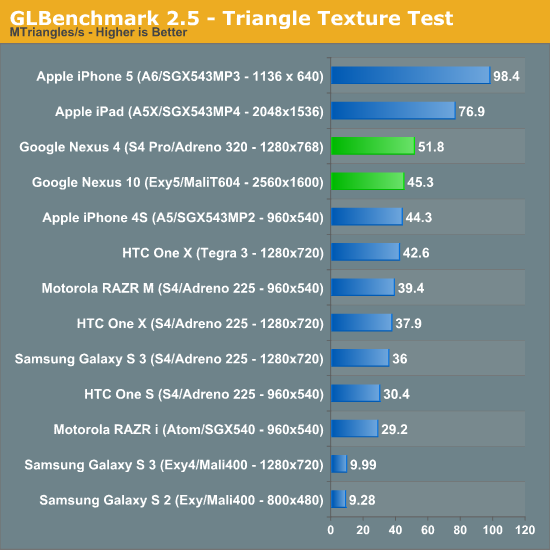
The T604 is ARM's first unified shader architecture, which gives it far more balanced pixel/vertex shader performance. The result is a more than 4x increase in triangle throughput compared to the Mali 400MP4. It's not enough to give the Nexus 10 the edge over the latest Apple devices, but it's a huge improvement over where ARM was in the previous generation. The Adreno 320 continues to be quite strong here as well.
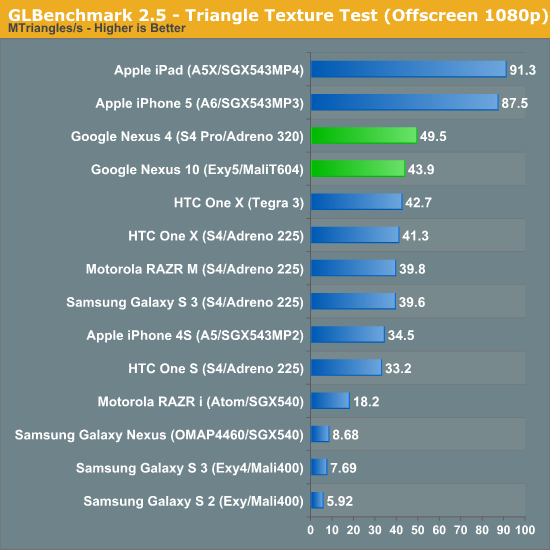
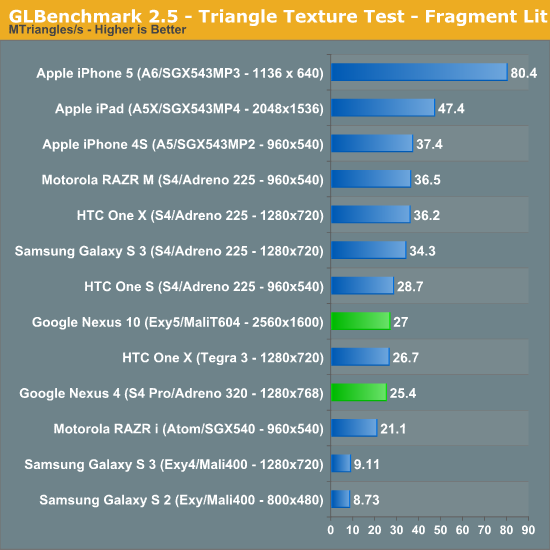
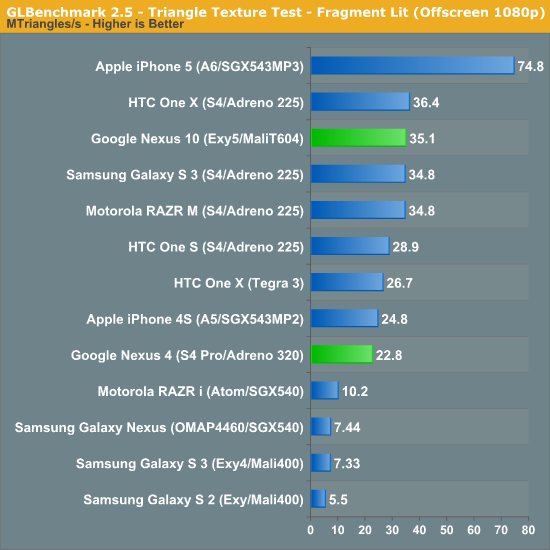
Once again we're seeing huge gains for the Mali-T604 compared to the Mali-400MP4. The Adreno 320 in the Nexus 4 actually performs worse than the Adreno 225 in older devices, possibly due to thermal throttling we saw on the Nexus 4 sample during periods of heavy load.
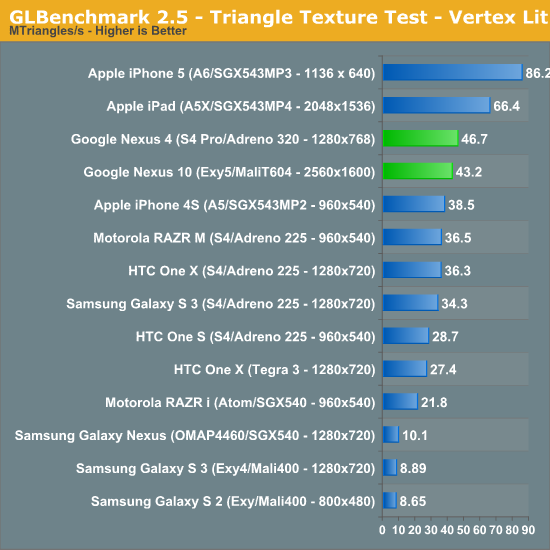
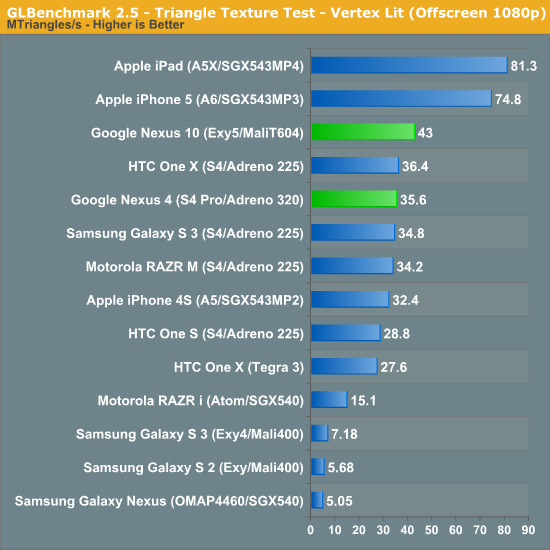
ARM shows the biggest gains here once again thanks to its move to a unified shader architecture. The Adreno 320 does ok here but it's really no better than the 225, I suspect there is some thermal throttling happening on the device.
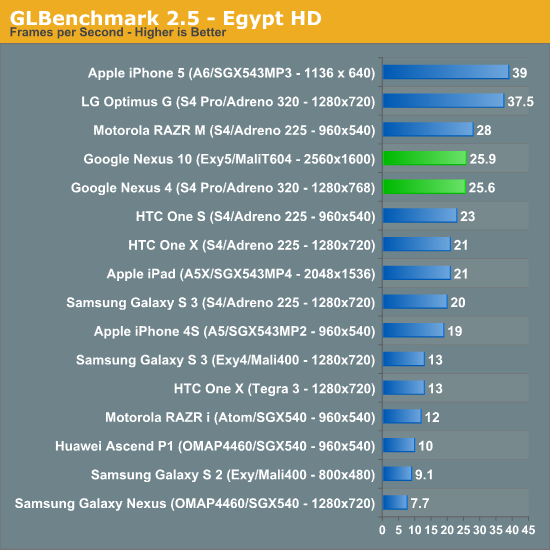
At native resolutions, the Nexus 10 and NExus 4 are both capable of putting out decent frame rates in Egypt HD. What this data tells us is they'll likely be able to run current and even some future titles, at native res, at 30 fps without much of an issue.
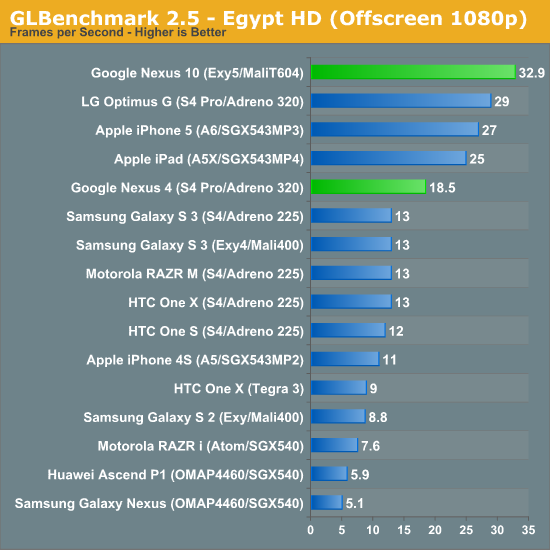
Normalize resolution and the Mali-T604 actually does very well here, setting a new performance record. Despite being based on the same hardware, the Optimus G is able to post a much higher score here than the Nexus 4. The explanation is simple: the Optimus G can't complete a single, continuous run of GLBenchmark 2.5 - the app will run out of texture memory and crash if you try to run through the entire suite in a single setting. The outcome is that the Optimus G avoids some otherwise nasty throttling. The Nexus 4 on the other hand manages to complete everything, but likely quickly throttles its clocks down due to thermal constraints. The Nexus 4 was really hot by the end of our GLBenchmark run, which does point to some thermal throttling going on here. I do wonder if the Snapdragon S4 Pro is a bit too much for a smartphone, and is better suited for a tablet at 28nm.
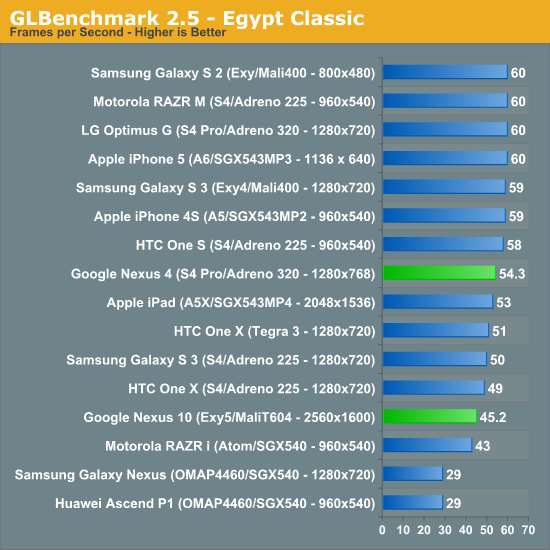
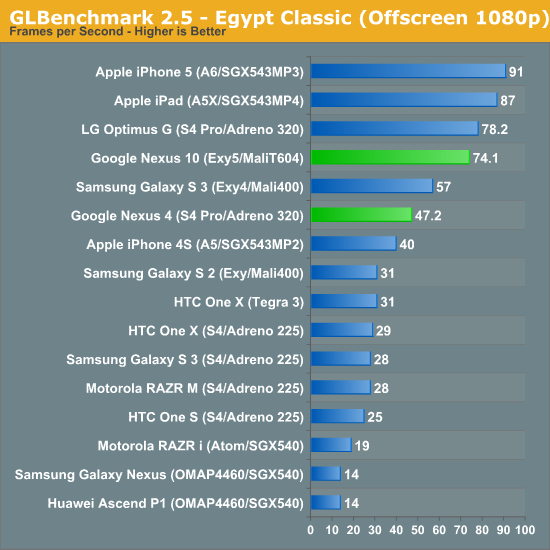
The Egypt Classic numbers are less interesting, but both platforms do well here.
Battery Life
We didn't have time to run through our entire battery life suite, but we do have some relevant results for the two devices. For smartphones, these are our latest web browsing battery life tests:
We regularly load web pages at a fixed interval until the battery dies (all displays are calibrated to 200 nits as always). The differences between this test and our previous one boil down to the amount of network activity and CPU load.
On the network side, we've done a lot more to prevent aggressive browser caching of our web pages. Some caching is important otherwise you end up with a baseband test, but it's clear what we had previously wasn't working. Brian made sure that despite the increased network load, the baseband still had the opportunity to enter its idle state during the course of the benchmark.
We also increased CPU workload along two vectors: we decreased pause time between web page loads and we shifted to full desktop web pages, some of which are very js heavy. The end result is a CPU usage profile that mimics constant, heavy usage beyond just web browsing. Everything you do on your smartphone ends up causing CPU usage peaks - opening applications, navigating around the OS and of course using apps themselves. Our 5th generation web browsing battery life test should map well to more types of smartphone usage, not just idle content consumption of data from web pages.
As always we test across multiple air interfaces (3G, 4G LTE, WiFi), but due to the increased network load we actually find that on a given process technology we see an increase in battery life on faster network connections. The why is quite simple to understand: the faster a page is able to fully render, the quicker all components can drive down to their idle power states.
All Android tests use Chrome and 5GHz WiFi unless otherwise listed.
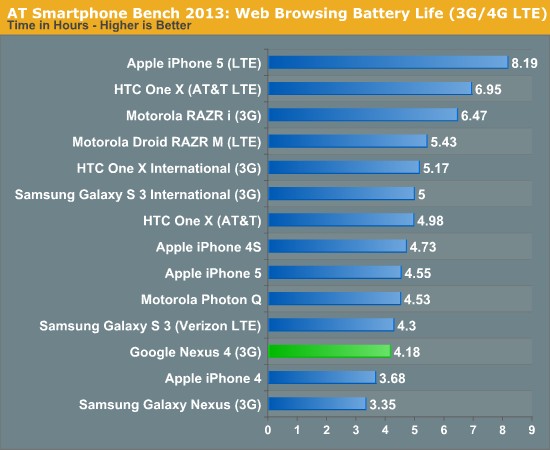
The Nexus 4 doesn't break any records for 3G battery life, it ends up relatively low on our list - even the Galaxy S 3 manages to do better here on 3G.

WiFi battery life is similar to the Galaxy S 3, but again it's not all that impressive compared to some of the other devices in this list.
Our tablet web browsing battery life test isn't directly comparable to the new smartphone tests, so we've got a separate chart for the Nexus 10:
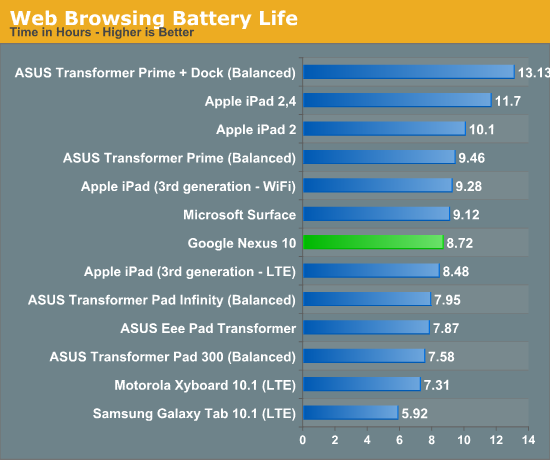
Despite driving a very high res panel, Google is able to deliver relatively competitive battery life with the Nexus 10. Battery capacity is around 80% the size of the 3rd gen iPad and battery life is around 93% of what Apple delivers here. Over 10 hours would be nice to have, but 8 hours of use in this test isn't bad at all. We'll have to do more testing to understand Exynos 5's power behavior a bit better, but so far it doesn't seem that the platform is all that bad from a power consumption standpoint. It remains to be seen how gracefully the Nexus 10 will handle being taxed heavier.
Display
We're still running our big display analysis routines on the new Nexus devices, but the brightness/contrast data below is a little teaser:
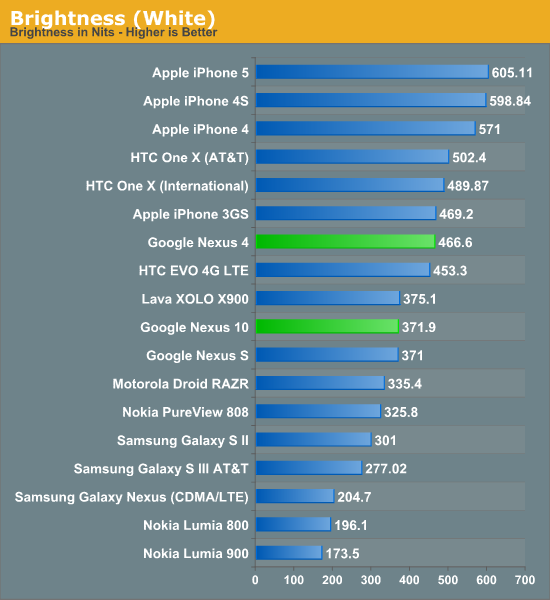
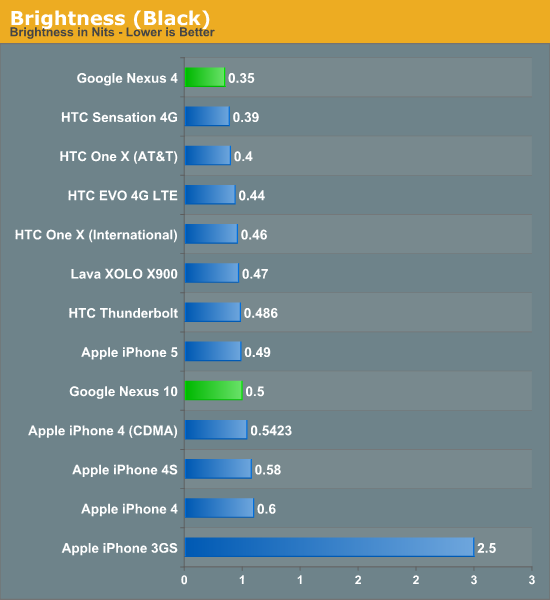
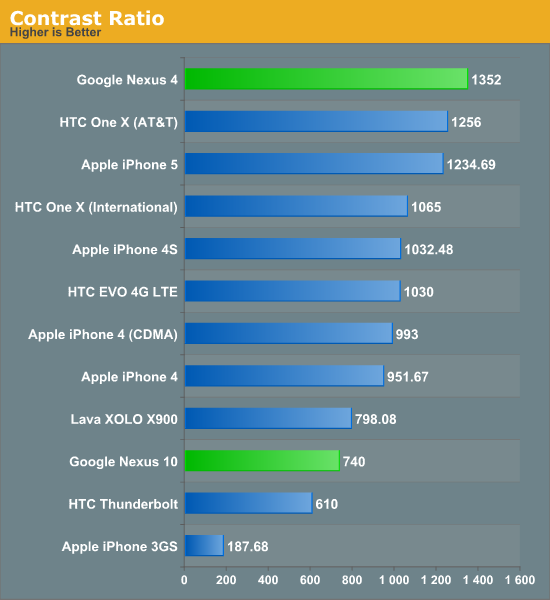
Final Words
We still have a lot of additional writing and testing ahead of us. Stay tuned for our full review of both devices!










244 Comments
View All Comments
UpSpin - Sunday, November 4, 2012 - link
A phone doesn't know when you don't need this stuff, so you have to tell the phone somehow that you don't need BT at the moment, ...Wifi always has to scan the surrounding to get detected and to detect access points. If it doesn't do this, it won't be able to connect on its own. But scanning consumes battery life.
The same with BT and every other bidirectional wireless technology.
GPS is different and it does go to sleep if no app needs it, but sometimes some apps request GPS even if not necessary. But then it's not the fault of Apple or Google, but the fault of you installing such a poorly written app. Because Apple doesn't allow background tasks and likes to limit the options of the user it's a minor issue on iOS but a bigger on Android, but it's your decision to use or not use such apps.
However, on android you just have to swipe down the status bar to get access to such settings in an instant. Or even better, use NFC tags, so the smartphone knows exactly what profile you like in the car, on your desk, in your office, ...
Or I use a setting/app which automatically turns on Wifi and off the lockscreen if my phone gets charged, because then I'm at home. So I don't have to do it either.
But never phones, thanks to NFC allow more comfortable options just as mentioned.
chippey5 - Wednesday, November 28, 2012 - link
Thanksvision33r - Monday, November 5, 2012 - link
Samsung S3 battery life is worst than the S2 or HTC One X. I switched over to iPhone 5 because the battery life on android is simply atrocious.The only way to stay close to Iphone is to get android with a big battery and increase the weight.
People use phones and they shouldn't require tinkering to be used easily. That's the main problem with Android is that it requires an insane amount of tweaking to use efficiently.
wlmeng11 - Saturday, November 17, 2012 - link
"get android with a big battery"http://source.android.com/source/downloading.html
I didn't see any options for getting a bigger battery here.
Please differentiate between hardware and software.
You can't get iOS with a big battery either.
BrandoHD - Sunday, November 4, 2012 - link
If it's draining that much overnight, then there is something keeping the phone awake, in the land of ANdroid, there are tools that can be used to find the issue and fix it, no need to wait on an update from AppleAs usual, in your effort to try to put blame on the device, it is clear that this is a PEBPAC
Problem Exists Between Phone And Chair - edited for relevancy
:-)
clsid - Friday, November 2, 2012 - link
I have owned Samsung Galaxy devices with poor battery life and compared to the iPhone 4S or the iPhone 5 it is truly an issue. If I get an Android phone it will have to be a Razr Maxx, otherwise an iPhone 5 is the right choice.Fx1 - Saturday, November 3, 2012 - link
iphone 4S wouldnt last from 8am to 8pm without charge. My S3 lasts from 8am to 2am with 15% left. This is with a huge screen and quad core.Dont forget i never charge my phone i just switch out batteries.
kmmatney - Saturday, November 3, 2012 - link
I routinely get 2+ days out of my iPhone 4S...doobydoo - Sunday, November 4, 2012 - link
My gf gets 2 days easily with her 4S.Sounds like you have a faulty battery.
KitsuneKnight - Sunday, November 4, 2012 - link
Similar to what others have said, my 4S also gets 2 days with fairly heavy usage. Hell, today I'd say I had rather light usage (probably only 30 minutes of streaming audio through the internal speaker, and some browsing), I've only dropped down to 92%.